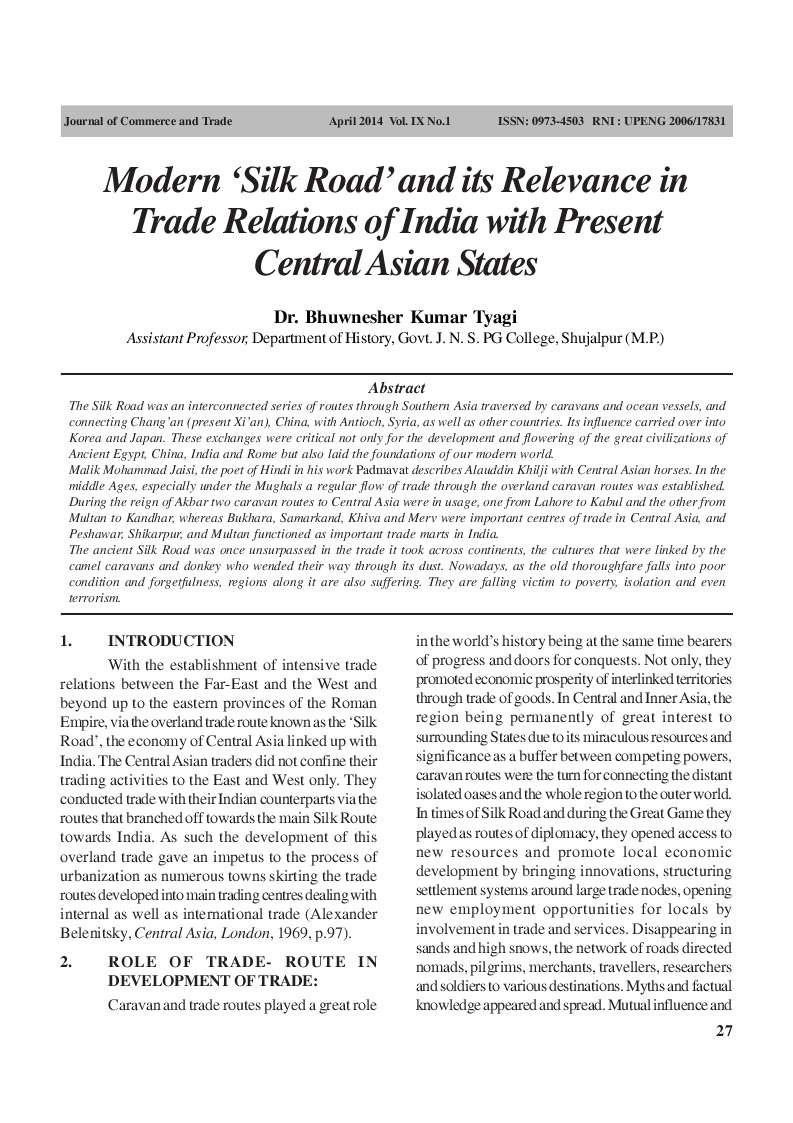Modern 'Silk Road' and its Relevance in Trade Relations of India with Present Central Asian Satates
DOI:
https://doi.org/10.26703/jct.v9i1.146Keywords:
Silk Road, Trade Relations, Central Asia, India, Malik Mohammad JaisiAbstract
he Silk Road was an interconnected series of routes through Southern Asia traversed by caravans and ocean vessels, and connecting Chang’an (present Xi’an), China, with Antioch, Syria, as well as other countries. Its influence carried over into Korea and Japan. These exchanges were critical not only for the development and flowering of the great civilizations of Ancient Egypt, China, India and Rome but also laid the foundations of our modern world. Malik Mohammad Jaisi, the poet of Hindi in his work Padmavat describes Alauddin Khilji with Central Asian horses. In the middle Ages, especially under the Mughals a regular flow of trade through the overland caravan routes was established. During the reign of Akbar two caravan routes to Central Asia were in usage, one from Lahore to Kabul and the other from Multan to Kandhar, whereas Bukhara, Samarkand, Khiva and Merv were important centres of trade in Central Asia, and Peshawar, Shikarpur, and Multan functioned as important trade marts in India. The ancient Silk Road was once unsurpassed in the trade it took across continents, the cultures that were linked by the camel caravans and donkey who wended their way through its dust. Nowadays, as the old thoroughfare falls into poor condition and forgetfulness, regions along it are also suffering. They are falling victim to poverty, isolation and even terrorism.
Downloads
References
Barani, Tarikh-i-Firoz Shahi.
Belenitsky, Alexander, Central Asia, London, 1969.
Frye, R.N. ( tr.) The History of Bukhara, 1954.
Gopal, S., Indians in Russia in the 17th and 18th century, New Delhi.
Guha, Amalendu (Ed.) Central Asia: Movements of Peoples and Ideas from Times Prehistoric to Modern, Delhi, 1970.
Nizami, K.A., India’s Cultural Relations with Central Asia During the Medieval Period.
Starr, S. Frederick (ed), The New Silk Roads, Transport and Trade in Greater Central Asia, Central Asia – Caucasus Institute, Silk Road Studies Progress, 26 October, 2008.

Downloads
Published
License
Copyright (c) 2014 Dr. Bhuwnesher Kumar Tyagi

This work is licensed under a Creative Commons Attribution 4.0 International License.










